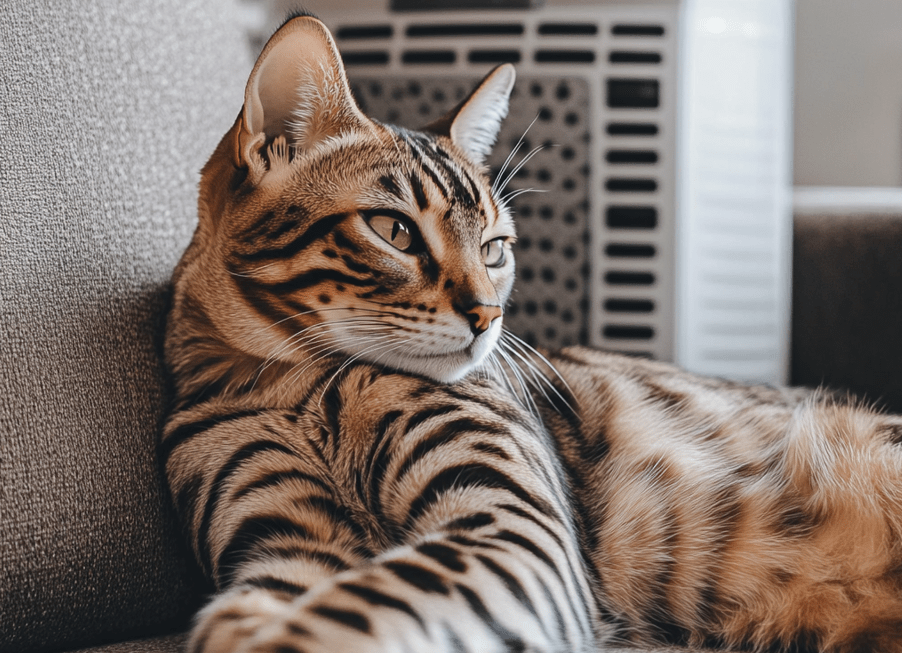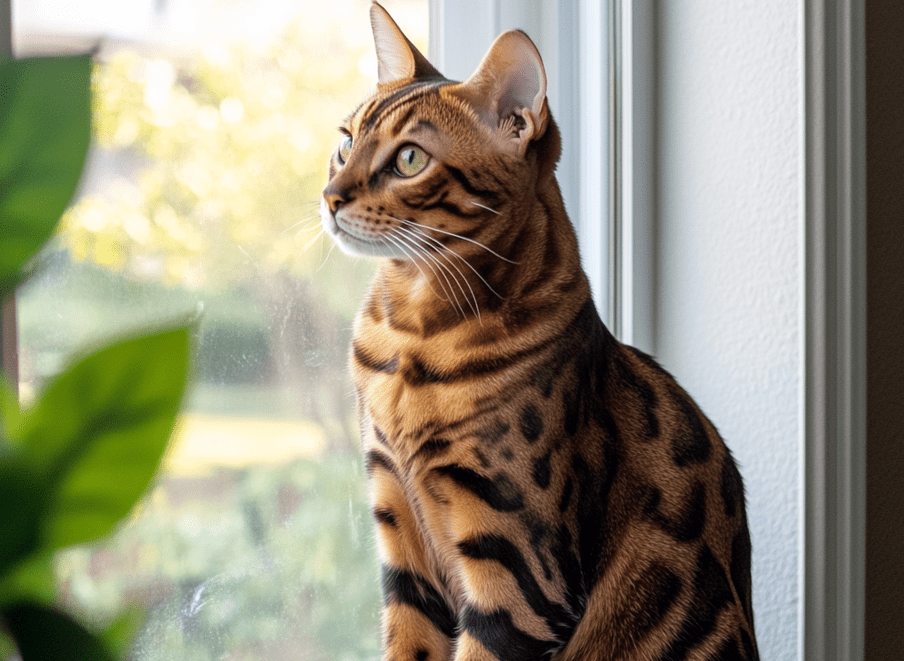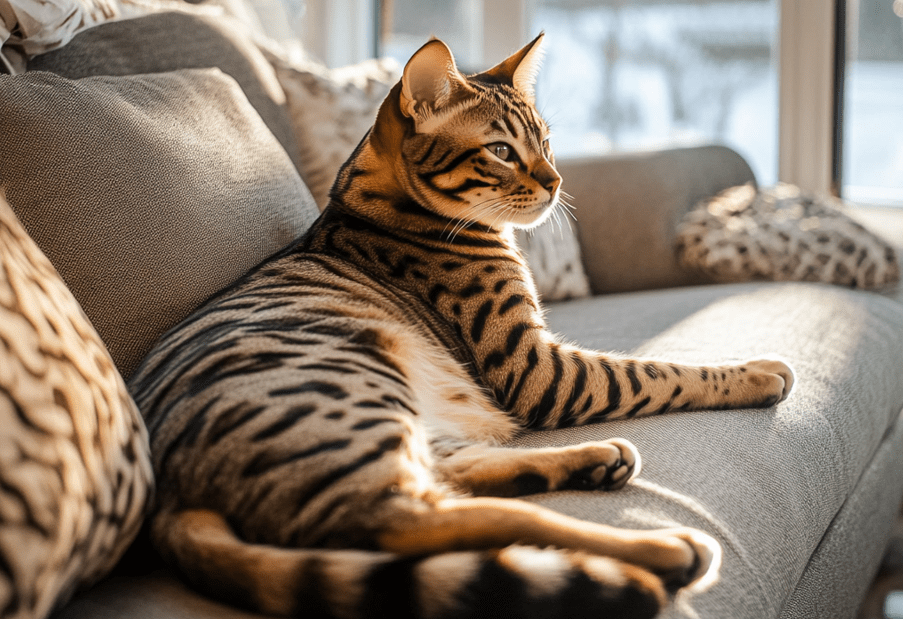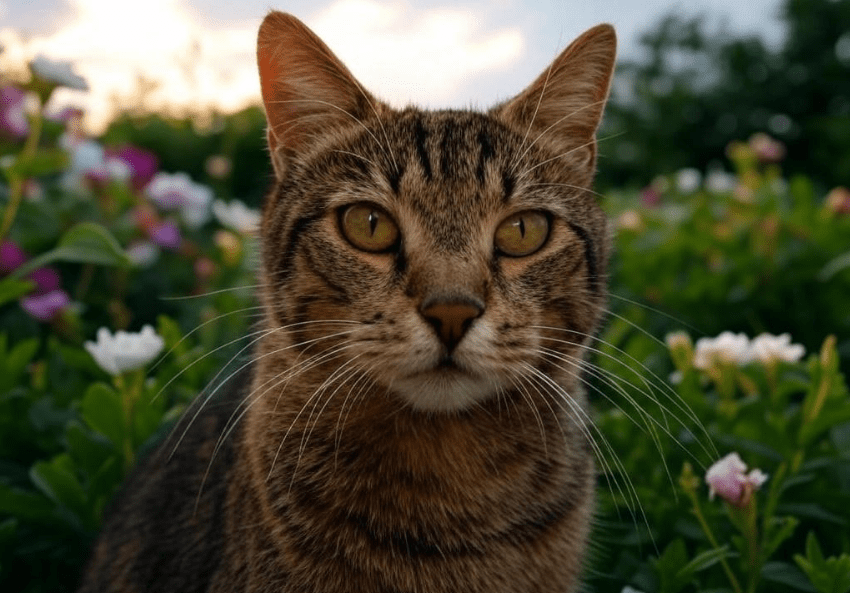
Bengal cats, with their striking appearance and vibrant personalities, are beloved for their intelligence and energy. However, their sensitive nature and wild ancestry can make them prone to stress, which may manifest as behavioral issues or health concerns. Learning how to reduce stress in Bengal cats through a consistent, well-structured routine is essential for their well-being and happiness. This comprehensive guide explores the causes of stress in Bengals, the benefits of a routine, and practical strategies to create a calming, enriching environment that fosters a relaxed and content feline companion.
Understanding Stress in Bengal Cats
Bengals are a hybrid breed, descended from the Asian leopard cat, which gives them a unique blend of domestic affection and wild instincts. Their high intelligence, energy, and sensitivity mean they can be more susceptible to stress than other breeds when their environment or routine is disrupted.
Common Causes of Stress in Bengals
Environmental Changes: Moving homes, new pets, or rearranged furniture.
Inconsistent Routines: Irregular feeding, play, or sleep schedules.
Lack of Stimulation: Boredom from insufficient mental or physical activity.
Social Stress: Conflicts with other pets or lack of human interaction.
Health Issues: Pain, illness, or discomfort can amplify stress responses.
Loud Noises or Chaos: Construction, visitors, or sudden sounds.
Signs of Stress in Bengals
Recognizing stress is the first step to addressing it. Look for:
-
Hiding or withdrawal
-
Excessive vocalization
-
Overgrooming or fur loss
-
Reduced appetite
-
Aggression or irritability
-
Restlessness or pacing
By creating a routine tailored to their needs, you can reduce stress in Bengal cats and help them thrive.
Why Routines Matter for Bengals
Bengals thrive on predictability, which provides a sense of security and control in their environment. A consistent routine minimizes uncertainty, reduces anxiety, and meets their physical, mental, and social needs. Benefits of a routine include:
Lower Stress Levels: Predictable schedules reduce the need to adapt to sudden changes.
Improved Behavior: A stimulated Bengal is less likely to act out destructively.
Better Health: Regular feeding and exercise promote physical well-being.
Stronger Bond: Consistent interaction builds trust and strengthens your relationship.
Building a Stress-Reducing Routine for Your Bengal
A well-structured routine should address your Bengal’s need for exercise, mental stimulation, social interaction, and rest. Below are practical steps to create a daily schedule that promotes calm and contentment.
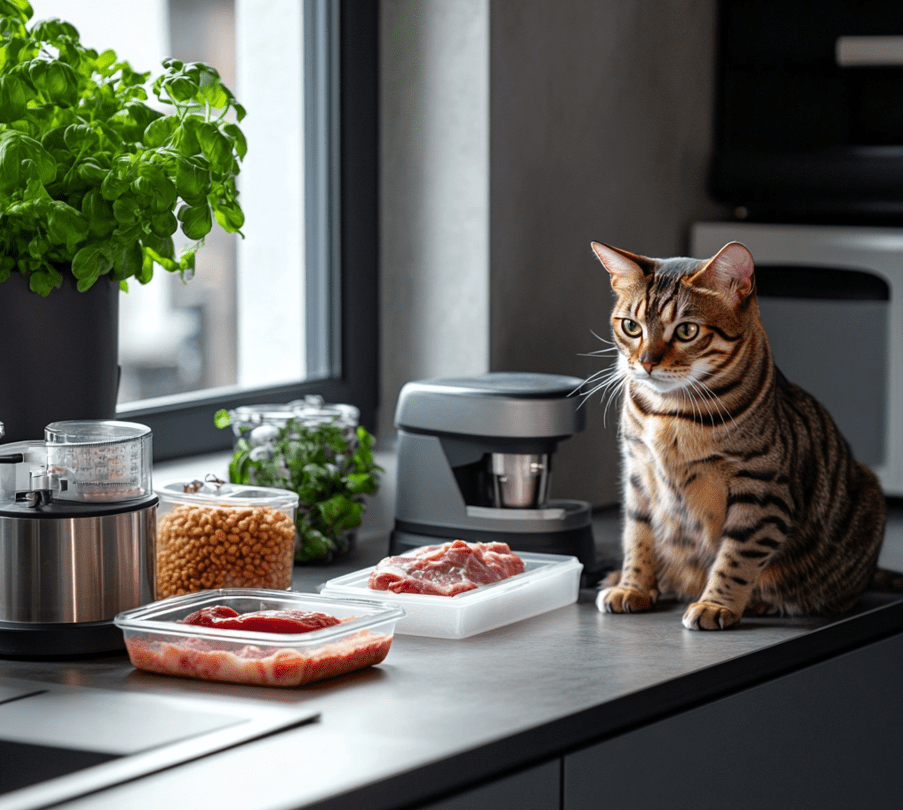
1. Establish Consistent Feeding Times
Bengals associate feeding with security, so a predictable meal schedule reduces stress.
Set Fixed Times: Feed your Bengal at the same times daily (e.g., 7 AM and 6 PM). Split meals into two or three portions to mimic their natural grazing behavior.
Use Puzzle Feeders: Turn mealtime into a mental challenge with treat-dispensing toys, reducing boredom and stress.
High-Quality Diet: Provide a balanced, protein-rich diet to support energy and health. Consult your vet for recommendations.
Fresh Water: Ensure constant access to clean water, ideally via a pet fountain, as Bengals love moving water.
Pro Tip: Avoid sudden diet changes, which can cause stress. Transition to new food gradually over 7–10 days.
2. Schedule Daily Play Sessions
Bengals are highly active and need regular exercise to burn energy and reduce stress. Structured playtime channels their instincts constructively.
Morning Play (15–20 minutes): Start the day with an interactive session using feather wands, laser pointers, or balls to mimic prey. This burns energy and sets a positive tone.
Evening Play (15–20 minutes): End the day with another active session to tire your Bengal before bedtime, promoting restful sleep.
Solo Play Options: Leave puzzle toys, automated laser toys, or treat-dispensing balls for midday entertainment when you’re away.
Outdoor Access (if safe): Leash-train your Bengal for supervised outdoor walks to explore new stimuli, reducing indoor restlessness.
3. Incorporate Mental Stimulation
Bengals’ intelligence requires mental challenges to prevent boredom, a major stress trigger.
Puzzle Toys: Use treat-dispensing balls, puzzle boards, or foraging toys to engage problem-solving skills.
Training Sessions: Teach tricks like “sit,” “fetch,” or navigating an obstacle course. Short, 5-minute sessions daily keep their mind sharp.
Scent Games: Hide treats or catnip toys around the house for your Bengal to “hunt,” satisfying their predatory instincts.
DIY Enrichment: Create puzzles with cardboard boxes, paper bags, or muffin tins filled with toys or treats.
4. Provide a Predictable Sleep Schedule
Bengals need 12–16 hours of sleep daily, and a consistent rest routine promotes relaxation.
Cozy Rest Areas: Offer multiple quiet, comfortable spots like cat beds, window perches, or tunnels for napping.
Evening Wind-Down: After evening play, dim lights and reduce activity to signal bedtime, helping your Bengal settle.
Avoid Disruptions: Keep their sleep areas free from loud noises or sudden interruptions, especially during naps.
5. Maintain Litter Box Consistency
A clean, accessible litter box is crucial for stress reduction, as Bengals are particular about hygiene.
Fixed Location: Place the litter box in a quiet, low-traffic area and avoid moving it.
Daily Cleaning: Scoop daily and deep-clean weekly to keep it inviting.
Multiple Boxes: Provide one box per cat plus one extra, especially in multi-cat homes.
Familiar Setup: Use the same litter type and box style your Bengal is accustomed to, as changes can cause stress.
6. Schedule Social Interaction
Bengals are social and thrive on human or pet companionship. Regular interaction reduces loneliness and stress.
Morning Bonding: Spend a few minutes cuddling or talking to your Bengal to start the day positively.
Evening Quality Time: After evening play, offer gentle petting or brushing to reinforce your bond.
Companionship: If you’re away often, consider a compatible pet (another cat or cat-friendly dog) to provide social stimulation.
Remote Interaction: Use interactive pet cameras to check in, talk, or play with your Bengal when away.
7. Create a Calming Environment
A Bengal-friendly environment minimizes stress triggers and promotes relaxation.
Vertical Spaces: Install cat trees, shelves, or window perches for climbing and observing, giving your Bengal a sense of control.
Hiding Spots: Provide tunnels, boxes, or cat condos for retreat during stressful moments.
Window Views: Place a perch near a window for bird-watching or outdoor entertainment, a natural stress reliever.
Pheromone Diffusers: Use products like Feliway to create a calming atmosphere, especially during transitions.
Quiet Zones: Designate areas free from loud noises or chaos for your Bengal to relax.
Sample Daily Routine to Reduce Stress
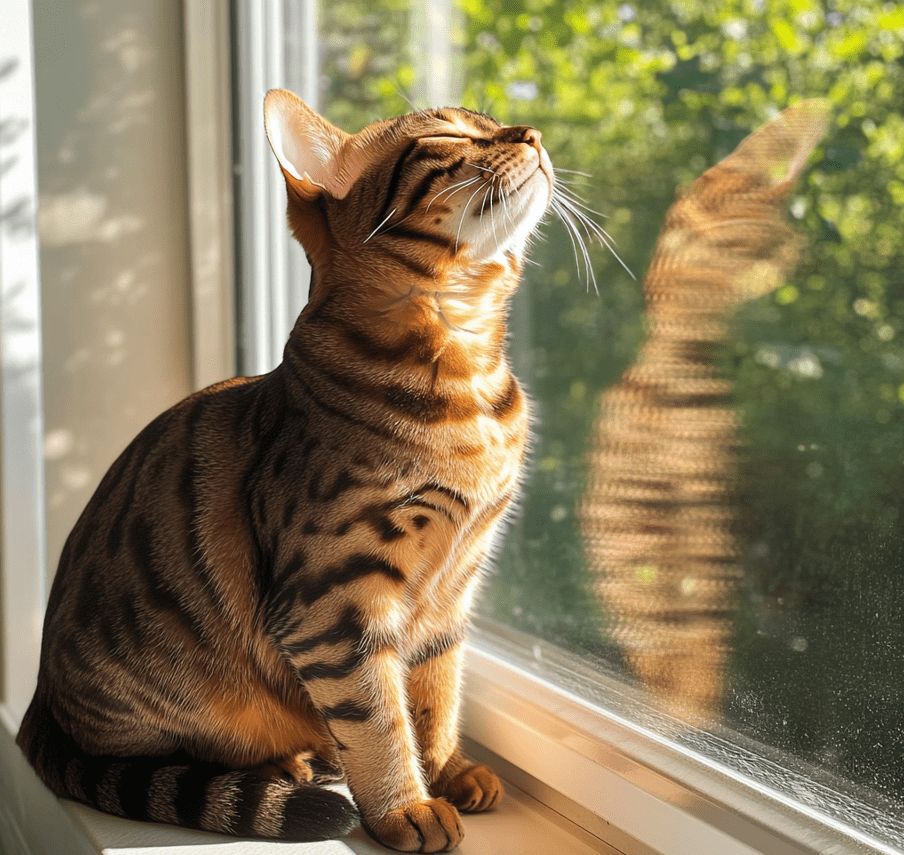
Here’s an example of a stress-reducing daily routine for a Bengal cat, adaptable to your schedule:
7:00 AM – Morning Feeding: Serve breakfast via a puzzle feeder, followed by a 15-minute play session with a feather wand.
8:00 AM – Bonding: Spend 5 minutes cuddling or brushing your Bengal.
10:00 AM – Solo Enrichment: Leave a treat-dispensing toy or automated laser toy for midday play.
12:00 PM – Litter Box Check: Scoop the litter box to ensure cleanliness.
3:00 PM – Window Time: Encourage your Bengal to relax on a window perch for bird-watching.
6:00 PM – Evening Feeding: Serve dinner, followed by a 15-minute play session with a laser pointer.
7:00 PM – Training: Spend 5 minutes teaching a trick or playing a scent game.
9:00 PM – Wind-Down: Dim lights, offer a cozy bed, and provide gentle petting to signal bedtime.
10:00 PM – Final Check: Ensure water, litter box, and rest areas are ready for the night.
Addressing Stress-Related Behaviors
Even with a routine, your Bengal may exhibit stress-related behaviors. Here’s how to handle common issues:
1. Hiding or Withdrawal
Hiding is a normal stress response. Provide cozy hiding spots and give your Bengal time to emerge. Sit nearby, speaking softly, to build trust.
2. Excessive Vocalization
Loud meowing may signal stress or attention-seeking. Ensure their needs are met, engage in play, and use calming aids like pheromone diffusers if needed.
3. Litter Box Issues
Stress can cause litter box avoidance. Verify the box is clean, accessible, and familiar. Consult a vet if issues persist to rule out medical causes.
4. Overgrooming or Fur Loss
Stress-induced grooming requires addressing the root cause. Enhance enrichment, maintain routine, and seek veterinary advice for skin or anxiety issues.
5. Aggression or Restlessness
Redirect aggressive energy with play and ensure a calm environment. If aggression persists, consult a behaviorist for tailored solutions.
Additional Tools to Reduce Stress
Beyond routine, these tools can enhance your Bengal’s sense of calm:
Calming Supplements: Vet-approved supplements like L-theanine or chamomile can reduce anxiety. Always consult your vet first.
Music for Cats: Play classical or cat-specific calming music to soothe your Bengal, especially when alone.
Massage or Brushing: Gentle brushing or petting mimics grooming, promoting relaxation and bonding.
Safe Outdoor Access: A catio or supervised leash walks provide novel stimuli without stress.
When to Seek Professional Help
If stress persists despite a routine, professional support can help.
1. Veterinary Evaluation
Chronic stress or sudden behavioral changes may indicate health issues like:
-
Hyperthyroidism
-
Pain or discomfort
A vet can diagnose and treat underlying conditions.
2. Feline Behaviorist
A certified cat behaviorist can assess your Bengal’s environment and routine, offering tailored strategies to reduce stress and improve behavior.
3. Medication
In severe cases, your vet may prescribe anti-anxiety medication for short-term use, combined with behavioral and environmental changes.
Conclusion

Creating a routine to reduce stress in Bengal cats is a powerful way to nurture their vibrant, sensitive nature. By addressing their need for predictability, exercise, mental stimulation, and social interaction, you can help your Bengal feel secure, content, and thriving. The strategies in this guide—from consistent feeding to enriching play—equip you to build a stress-free environment tailored to your Bengal’s unique needs. Start implementing these tips today, and watch your Bengal flourish into a happy, well-adjusted companion in a harmonious home.


